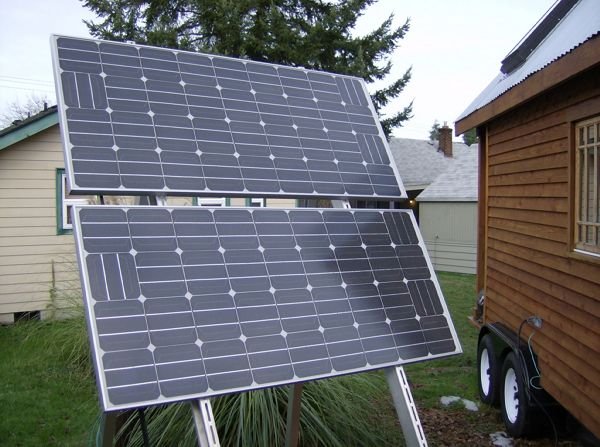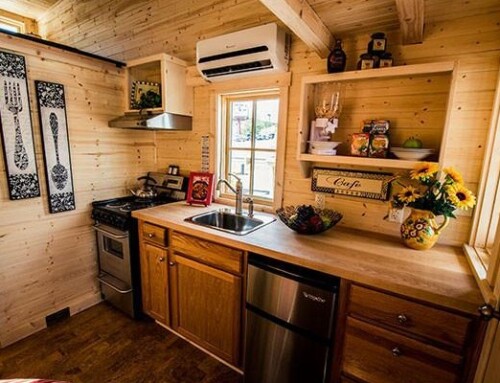Can You Rely On Solar Power For Your Tiny House RV?
The short answer is – YES, but you’ll need to determine which solar system will work for you. Do this by calculating: 1) Your energy needs, 2) Your expected sun hours based on your geographical location, and 3) The optimal weight and size of your system
Ariel’s Solar Powered 172 square foot Tumbleweed Cypress
How Can I Calculate My Energy Needs?
First, try using a solar calculator to determine your current electrical usage. You can also calculate your energy needs using this appliance chart. Next consider energy efficient or alternative powered appliances for your Tiny House RV to reduce your electrical usage and the overall size of your solar system.
Can you use an energy-star refrigerator or a propane refrigerator?
Can you switch your lights to LEDs?
Can you heat your space with a wood or propane stove?
Can you heat your water with propane?
Can you cook with propane instead of electricity?
Do you need a blender? A coffee machine? A microwave? A washer / dryer? A big TV?
“Tiny The Movie” Colorado Tiny House RV, powered by Sol Man Portable Generator
How Can I Calculate My Expected Sun Hours?
If you do not plan on moving your Tiny House RV, use this chart to determine your average daily sun hours. Keep in mind, you can expect less sun in some seasons.
Ryan Mitchell’s Tiny House RV Solar Panel Set Up in North Carolina
If you plan on traveling with your Tiny House RV, it may be difficult (or impossible) to determine your average sun hours. You may want to purchase a larger solar system or reduce your electrical need. If you are caught in bad weather on your trip, and your solar system can not keep up, you can rely on campgrounds for an electrical outlet. You may also want to carry backup power – such as a gas generator.
Tiny House Giant Journey‘s Goal Zero Yeti Solar Generator
Weight & Size of the your Solar System
Solar panels, batteries and inverters are usually heavy and bulky. This is an important consideration when determining the preferred system for your Tiny House RV. If you do NOT plan on moving your Tiny House RV, you can build an external shell for your batteries. You can then park your Tiny House RV in an ideal sun exposure location and mount solar panels to your roof, or mount your panels on a swivel rack that can turn for optimal sun exposure.
If you intend on traveling with your Tiny House RV, you will need to take care when considering the weight and storage of your solar system. I’m going to speak from my personal experience, as I travel with my solar powered Tumbleweed Cypress.
My Portable Solar System
I use the Goal Zero Yeti 1250 Solar Generator with four solar panels (two 100 watt panels and two 90 watt panels). I have one panel mounted to each side of my Tumbleweed for transport and the other two are stored in the bed of my truck. The panels in my truck charge my Yeti Solar Generator as we travel down the road.
You can see one of my panels mounted to the side of my Tiny House RV in the above photo. The mount is also a hinge, and I add telescopic legs to prop the panel for ideal sunshine
I do not suggest mounting solar panels to the roof of your Tiny House RV if you intend on traveling, for two reasons: 1). You may not always park in an area with optimal sunshine. Having my panels separate and portable allows me to position and clean them easily. 2). Damage may occur from low hanging branches to panels mounted to your roof.
What I Love About the Yeti Solar Generator:
– It’s an all-in-one system. The inverter, batteries and charge controller are combined to create a “solar generator.” *Note: the Yeti generator cannot generate power without solar panels.
– It’s extremely portable. It’s on wheels! We store it in the cab of our truck when we are on the road.
– I can recharge it from a regular outlet if there is no sun.
– It weighs only 103 lbs. That may sound like a lot, but lead-acid batteries are heavy.
– It’s affordable. $1599 for the Yeti Solar Generator. That’s cheap for solar!
– It powers almost everything in my Tiny House RV. The Yeti can keep my computers, phones, and cameras charged, as well as my LED lights and water pump powered forever, as long as I have sunshine. It’s a small system – only 1250 watt hours, so I cannot use my hair dryer nor my space heater. I use alternative appliances to lower my electrical need: propane water heater, propane stove top, propane refrigerator, and a wood stove heater.













The wording of your article might confuse readers a bit, and I wouldn’t want anyone to order these products and expect to realistically be able to live off the grid. The Yeti Solar Generator you use is a battery bank, designed to store the energy you need with the capability to be plugged into devices for recharging. It has the storage capacity of 1200Wh, or 100Ah @ 12V. This device gets power from the 4 solar panels you have, which total 380-watts. As it states in the Goal Zero website, 1 90-watt solar panel will take 27-54 Hours to fully recharge the 1250 Yeti Solar Generator. Let me repeat for emphasis – it will take ONE to THREE DAYS to absorb sunlight and charge the battery bank using the 90W solar panel.
I’m sure its a great kit for camping, it’s just not realistic for full time use in a tiny house.
Instead, tiny homesteaders should look for solar panels with MUCH HIGHER wattages – 250 to 350 watts each, and a battery bank with 500 to 1,000Ah capacity.
The Tiny Solar House I live in has 6 280W panels, total of 1,680 watts worth of solar, and a 750Ah battery bank at 12V. This is enough to power the entire house (full size fridge, water pump, lights, fans, etc.). I encourage readers of this article to visit tinysolarhouse.com to learn more about solar and get a realistic understanding of the components needed to functionally take a tiny house off the grid.
http://www.tinysolarhouse.com
Powered By The Sun
I also agree that being tied to the grid is one of the best options when choosing to go solar. But, as the person above mentioned, Tesla has released their Power Wall. I think this technology is great for those who have tiny houses. Especially for those who want to live off the grid.
The model you recommended is no longer available (just so you and your readers know!)